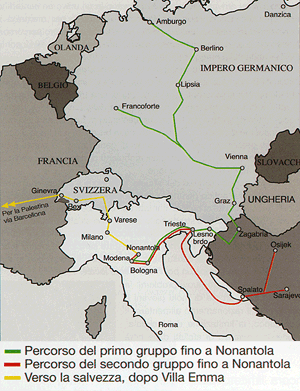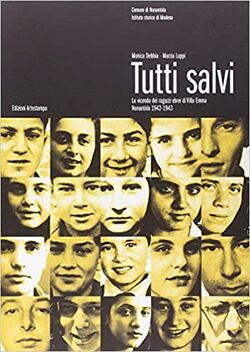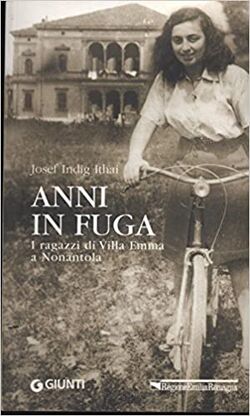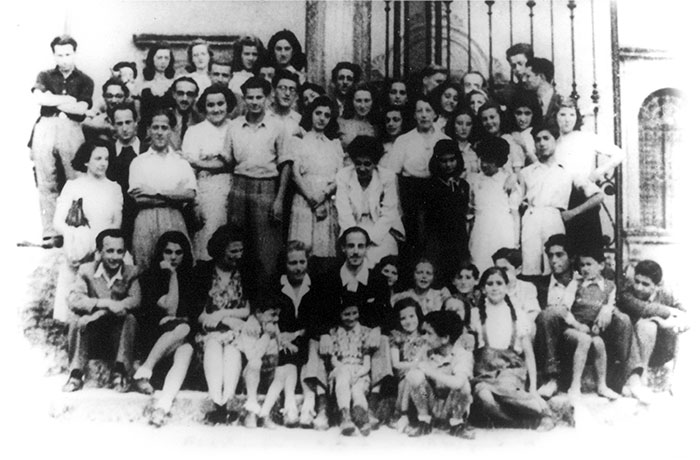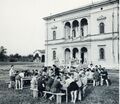Category:Nonantola Children (subject)
Villa Emma, Nonantola / Nonantola Children (see Holocaust Children Studies & Italian Jewish Studies)
Overview
The Nonantola Children were the 73 Jewish children, adolescents and young adults from Central Europe who were hosted at Villa Emma in Nonantola in 1942-43 and were then safely smuggled to Switzerland in Oct-Dec 1943 (together with three additional Jewish children from Libya). The original group originally consisted of 74 children: 40, led by Josef Indig, come from Slovenia to Nonantola where they were joined by an additional group of 34 younger children from Spalato (one of the children from this second group was the only victim). The 3 Libyan children were interned in the village of Nonantola (not at Villa Emma) with their families; they joined the Nonantola children in their flight to Switzerland after Sep 8, 1943.
The 73 survivors were 34 girls and 39 boys. 13 were children, males and females, ranging between the age of six and twelve. 42 were adolescents between thirteen and seventeen, and 18 were young men and young women between eighteen and twenty-one.
After the Nazis occupied Italy in Sept 1943, all the children (73) were hidden with the help of the local population, until they were able to flee illegally to Switzerland. Only one of them (Salomon Papa) who was sick was left behind at the hospital and perished at Auschwitz. With the survivors there were also a group of Libyan Jews who had been interned at Nonantola, including 3 children. A total of 73+3 children arrived in Switzerland in small groups in Oct 1943. The original Nonantola group gathered again at Villa de Bains at Bex, Switzerland. There, an additional group of 30 children (and 8 adults) from Bergen-Belsen (Kastner Train) joined them on their way to Palestine.
In Depth
In the afternoon of July 17th, 1942, a group of forty young Jewish refugees from Germany and Austria arrived at the Nonantola railway station. They were accompanied by nine adults. Most of them came from Berlin, others came from Frankfurt, Leipzig, Hamburg, Vienna, and Graz. Almost all of them were orphans or their closest relatives had been arrested after the »Kristallnacht« in November 1938. Several of the children came from families who had immigrated from Poland and had thus been subjected to even harsher persecution beginning 1933.
There were originally directed to Palestine. On April 6th, 1941 they had been held up in Zagreb by the German invasion. From there, led by Josef Indig and thanks to a special authorization of the Italian Ministery of Interior, they moved to Slovenia, where they lived for one year, in Lesno Brdo. When fightings reached them, they were forced to leave, once again.
Then, an Italian Jewish organization, known as Delasem (Delegazione Assistenza Emigranti Ebrei) found an ideal place to lodge the young refugees. It was a long time unhabitated mansion in Nonantola, called Villa Emma.
On April 14, 1943, 33 more boys and girls from the Croatian city of Split arrived at Villa Emma. Most of their families were incarcerated or had been murdered at camps which had been set up by the National Socialist occupiers or the fascist Ustaša regime in Croatia.
On April 10th, 1943, thirty-three other Jewish boys and girls joined the original group. They arrived from Split, accompanied by Yakov Maestro and had managed to flee from Bosnia and Croatia. Like the first group, they could count on an official authorization. Overall, they were younger than those already housed at Villa Emma. This fact, alongside language differences, resulted in a somehow complicated relation between the two groups.
It was quite difficult and expensive to supply with food such a large group of people, in a period of food rationing. Black market turned out to be an inevitable option. Luckily, the refugees could count on supplies coming directly from the rural environment they lived in. From time to time they starved, although their leaders managed to skillfully obtain commodities.
When the young refugees arrived in Nonantola, they found themselves in a rural context. This greatly differed from their places of origin, as far as mentality and material conditions. Nonantola is a countryside village, not far from Modena. In 1942, it counted 10.746 inhabitants, many of them living in nearby hamlets. Agricolture was the main occupation and it employed around 80% of the active population. Professionals, including members of the clergy and school teachers, were about thirty people.
Upon closer examination, the Villa Emma young refugees were a mixed and varied group, with regard to age and gender: thirty-four girls and thirty-nine boys. There were thirteen children, males and females, ranging between the age of six and twelve. Forty-two adolescents between thirteen and seventeen and eighteen young men and young women between eighteen and twenty-one.
The idea of attending the Jewish School in Modena was soon discarded. Around the middle of October 1942, various courses were organized at the Villa: four classes for each age level. The youths studied Music, Literature, History, Philosophy, Anthropology, Judaism, Sionism and Modern Hebrew. Moreover, they learned Italian. It was also decided to keep a school register: class attendance was compulsory. On the other hand, students were free to decide about taking an exam.
To support their school activities, the students could count on a rich library. Its core was made of books they had brought along from Lesno Brdo. Other book, mostly in German, were later added thanks to the Delasem organization. There were also music scores for piano and singing, some records and a grammophone. In addition to classes, they were trained in agricultural works and handicrafts, under the guidance of peasants and craftsmen from Nonantola.
Soon, however there were contrasts concerning the organization of cultural activities. Umberto Jacchía, the director nominated by Delasem, would have liked more time to be devoted to Jewish traditions and Italian literature. Indig, a young Sionist activist, with lay and Socialist leanings, did not agree: “It is a farce, if you consider that this group of youths reached by chance Fascist Italy, while it should be prepared to its future life in Palestine!” (J. Indig).
Any discussion with Jacchía was hopeless. The Italian Jews who lived at Villa Emma, where the Delasem organization had also moved its warehouse, were worried. At some point every exit from the Villa had to be authorized in writing by the director, Umberto Jacchía. Then, especially the older refugees, began to go to the village “covertly”, and came back with the feeling they had won a challenge.
At first there were also other problems and reasons of bewilderment that affected both the young refugees and the static and witdrawn local society. Both the refugees and the inhabitants of Nonantola had encountered people who were quite distant from their imagination. There were language differences, different lifestyles and mentalities. These young refugees, who came from far away, spoke various languages and quickly learned Italian. They aroused the curiosity of the local population because they belonged to another and unknown world. Moreover, they did not fall within the usual judgement benchmarks of the local people. These facts, however did not contrast the positive dynamics of good reception.
Indig realized that in Nonantola only a few joined Fascism. Those few ones did it “for more or less practical reasons” (J. Indig). This especially because in the area the regime showed the petit bourgeois and apparatchik face of Carlo Zanni, a lawyer who was podestà from 1930 to 1943.
Josef Indig, Don Arrigo Beccari, Giuseppe Moreali (1964)
Josef Indig, Don Arrigo Beccari, Giuseppe Moreali (1964)
For the young refugees of Villa Emma, war seemed far away until the summer of 1943. On July 25th, the people in Nonantola and in other places, celebrated the fall of Mussolini. Despite the fact that Marshal Badoglio, the new Chief of the Government, declared: “War continues”.
In August, as a precaution, the adults responsible for the Villa Emma group, asked the local authorities for new identity papers. They were issued without the note “belonging to Jewish race”.
On September 8th, everything changed. When the Armistice with the Anglo-Americans was announced, those who were responsible for the group immediately asked Giuseppe Moreali for help. He was the local physician. In the previous months he had weaved meaningful relations with the Villa Emma community. They were all aware the situation was getting dangerous and they had to find hiding places for the young refugees. The Villa was not a safe place anymore.
Doctor Moreali thought the best solution was to turn to don Arrigo Beccari and ask for his help. He was the treasurer of the Seminary annexed to Nonantola Abbey. With the permission of the Rector, mons. Ottaviano Pelati, he offered hospitality for some nights to a wide number of boys in the seminarists’ rooms.
When the German soldiers entered in Nonantola, the next morning, September 9th, Villa Emma had been abandoned. The largest part of the group was hiding in the Seminary. The others had been welcomed by numerous local families.
The young refugees, however, could not hide any longer in Nonantola. The possibility of a Nazi roundup was more and more realistic. Their new identity papers allowed them to pass unscathed German Feldgendarmerie and Italian police controls. The initial idea to take the group to the South of Italy and meet the Allied forces, soon waned. Only some of the elder youths went South. At that point, Switzerland became the only alternative.
They youths and their leaders left Nonantola divided in three groups, between October 6th and 16th, 1943 and reached Switzerland adventurously. After the first attempts to cross the border that ended with rejection, our young refugees managed to get in touch with the Jewish organization in Switzerland. They interceded with the Swiss authorities.
The young refugees finally found shelter in Switzerland. After a period they spent in different refugee camps, the members of the group met again at Villa des Bains, near Bex. After the war, almost all of them sailed from Barcelona to Palestine, where they arrived on May 29th, 1945.
Everyone was safe, except for Salomon Papo and Goffredo Pacifici. Salomon, fifteen years old, had reached Nonantola with the group from Split. Ill with tubercolosis, he was sent to the sanatorium in Gaiato di Pavullo and could not follow the rest of the group on its way to Switzerland. He was arrested in March 1944 and his name is listed among deportees from Fossoli to Auschwitz, with the April 5th train. Goffredo Pacifici, a Delasem official, lived at Villa Emma and led the youths, when they fled to Switzerland. Having reached the Swiss border, he decided to remain on the Italian side, to help other Jews to cross onto the safe side. He was later arrested with his brother by the Fascist militia, and deported to Auschwitz, where he died.
A spectacular example of the organizational capacity of the DELASEM relates to the saving of the children of Villa Emma at Nonantola. Due to the efforts of Father Arrigo Beccari and Giuseppe Moreali, in less than 36 hours upon arrival of the Germans in September 1943, more than a hundred residents of the DELASEM orphanage were hidden among the families of the area and subsequently transferred illegally to Switzerland. Only one of them, Salomon Papo, who was sick and had been entrusted to a sanatorium, was captured and died at Auschwitz. The book Fields of the Duce: the civilian internment in Fascist Italy (1930–1943), by Charles Spartacus Capogreco, details this escape, and 2004 television movie The Flight of the Innocents was made by European station RAI.
Book : Tutti salvi (2002)
- Monica Debbia, Marzia Luppi, Tutti salvi. La vicenda dei ragazzi ebrei di Villa Emma, Nonantola 1942 – 1943 (Comune di Nonantola, Istituto storico di Modena, Edizioni Artestampa, Modena 2002).
Quaderno didattico che prende spunto dalla vicenda dei ragazzi di Villa Emma per affrontare il vasto tema del secondo conflitto mondiale inteso come “grande contenitore di storie”, passando dal contesto locale ad una prospettiva di storia europea. Ricco di documenti di varia tipologia, organizzati in percorsi tematici; si presenta come uno strumento utile al laboratorio di storia ... La vicenda di Villa Emma - una grande casa padronale a Nonantola, nei pressi di Modena, dove fu nascosto e aiutato a fuggire un gruppo di ragazzi ebrei - è un episodio della seconda guerra mondiale che può considerarsi simbolico della solidarietà che tanta parte della popolazione civile seppe dimostrare agli ebrei perseguitati dai nazifascisti. Le autrici hanno costruito con questo testo uno strumento di lavoro ricco e approfondito, che nelle tre sezioni Perseguitati, In fuga e Villa Emma - ripercorre le fasi essenziali dell'episodio, mettendo chiaramente in luce i rapporti tra la singola vicenda e la grande storia."--Publisher description <Italian>
Book :
- Ombretta Piccinini, Klaus Voigt, I ragazzi ebrei di Villa Emma a Nonantola (Comune di Nonantola, Archivio storico comunale, 2002).
Catalogo della mostra esposta permanentemente a Nonantola e itinerante in Italia e in Europa; costituisce l’apparato iconografico del volume di Klaus Voigt. Permette di attribuire un volto ai protagonisti della vicenda di Villa Emma, di ricostruire le tappe del lungo viaggio e di cogliere aspetti della vita quotidiana nel corso degli anni in fuga.
Book : (2004)
- Josef Indig Ithai, Anni in fuga. I ragazzi di Villa Emma a Nonantola, a cura di Klaus Voigt (Giunti, Firenze-Milano 2004).
Costituisce l’unica testimonianza che abbraccia l’arco complessivo della vicenda dei ragazzi ebrei arrivati a Nonantola nel 1942 e poi fuggiti, nell’autunno del 1943, alla volta della Svizzera. Redatto dall’autore, educatore-accompagnatore del gruppo da Zagabria fino alla salvezza e all’arrivo in Palestina, è stato poi rielaborato in anni successivi. Il curatore, Klaus Voigt, ha condotto una ricognizione sulle diverse redazioni del testo.
Book : (2007)
- Maria Laura Marescalchi, Anna Maria Ori, Nonantola e i salvati di Villa Emma. Una guida per la scuola e per i visitatori (Quid Edizioni, Nonantola 2007)
Strumento agile che si propone di offrire gli elementi fondamentali per conoscere una storia e un luogo, unendo alle esigenze della divulgazione il rigore delle informazioni storiche. Il testo offre stimoli e prospettive di approfondimento sia a insegnanti e studenti, sia a quanti visitano i luoghi nonantolani legati alla vicenda. La guida è corredata da una significativa rassegna di immagini e documenti, 11 profili biografici e una cronologia comparata.
The Children
The Slovenia Children (from Germany-Austria to Zagreb, Lesno Brdo and Nonantola)
Children & Adolescents:
- Fritz Awin (M / Austria, 1927), Holocaust survivor -- 17 Feb 1927 (Vienna)
- Sonja Borus (F / Germany, 1927), Holocaust survivor -- Sonja (Sala) Borus (23 Feb 1927)
- Benno Goldberg (M / Germany, 1933), Holocaust survivor (6 Jul 1933)
- Jakob Goldberg (M / Germany, 1929), Holocaust survivor (8 Aug 1929)
- Ursula Karger (F / Germany, 1927), Holocaust survivor
- Joachim Kirschenbaum (M / Germany, 1927), Holocaust survivor
- Manfred Korenstein (M / Germany, 1928), Holocaust survivor
- [[Tamara Licht (4 Sep 1936) -- Arr 8 Oct 1943
- Bertha Reich (F / Germany, 1927), Holocaust survivor (8 Mar 1927 or 3 Aug 1927)
- Eva Reich (F / Germany, 1927), Holocaust survivor (8 Oct 1927)
- Lola Schindelheim (F / Germany, 1929), Holocaust survivor (Berlin, 15 Apr 1929)
- Hans Silbermann (M / Austria, 1927), Holocaust survivor (Vienna, 4 May 1927 or 5 Apr 1927)
- Gerda Tuchner (F / Germany, 1929), Holocaust survivor (Berlin, 21 Apr 1929)
Young Adults:
- < Edgar Ascher (6 Jan 1921) >
- < Mala Braun (F / Poland, 1921), Holocaust survivor >
- < Ruth Drucker (16 Jun 1925)
- < Susanne Elster (26 May 1923) - Susanne Malten-Elster
- < Betty Endzweig (Berlin, Germany, 21 Sep 1926)
- < Frieda Endzweig (DA VEDERE)
- < Max Federmann (M / Germany, 1923), Holocaust survivor>
- < Kurt Hahn (15 Sep 1923)
- < Emanuel Issler (5 Feb 1925)
- < Sigfried (Sigi) Kirschenbaum (1925)
- Leo Koffler (???)
- < Otto Liebling (7 Jun 1925)
- Salomon (Salli) Majerowicz (???)
- < Herbert Mohler (12 Jan 1923)
- < Tilla Nagler (14 Aug 1923)
- Eva Rosenbaum (???)
- < Joseph Schiffmann (2 Oct 1923)
- Kurt Schneider (???)
- < Fanny Senft (24 Dec 1925)
- < Hildegard Steinhardt (26 Mar 1925)
- < Hans Sussmann (3 Apr 1922)
- < Leone (Leo) Teplitzki (8 Oct 1922)
- < Laszlo Toeroek (23 Jan 1924)
- < Arnold Wininger (Leipzig, Germany, 29 Dec 1926)
- < Robert Weiss (M / Austria, 1923), Holocaust survivor>
- < Gisela Wiesner (Gisela Adler) (19 Apr 1924)
- < Blume Zwick (4 Aug 1926)
Adults:
- Mauricy Anwin (1895), Helene Barkic (1914), Josef Indig, Boris Jochvedson (Georg Bories, 1900), Alexander Licht (1884), Erna Licht (1897), Marek Silberschatz (Marco Schoky, 1907), Robert Stein (1908), Josefine Weiss (1892)
The Spalato Children (from Yugoslavia to Dalmatia and Nonantola)
Hundreds of Yugoslavian children came to Italy as refugees from Spalato with their family; see Spalato. Among them there was a group of 34 orphans who Jakob Altaras guided to Villa Emma, near Nonantola, Italy, by ship to Trieste and then by train via Venice and Bologna in April 1943. When Germany began occupying Italy in September 1943, the monks of the nearby Nonantola Abbey helped the children reach Switzerland. All survived except except one boy who had to be sent to the Hospital, was arrested and perished in Auschwitz. {[The copy print depicts the refugee children, Jakob Altaras (top right corner, between the door and window), and additional members of the Jewish community of Split including Rabbi Avraham Altaras (to Jakob’s left, next to the shutter), Jachiel Kamchi (below Avraham), Marcus Finzi (far right, below the window), Vittorio Morpurgo (top center), Iso Hermann (to Morpurgo’s left), and Moritz Levi (to Morpugo’s right).}}
Children & adolescents:
- Albert Albahari (M / Yugoslavia, 1927), Holocaust survivor (7 Oct 1927)
- Lezo Altarac (M / Yugoslavia, 1928), Holocaust survivor -- Eliezer (Lezo) Altaras (Altarac) M / Yugoslavia, 20 Jun 1928
- Ella Altarac (F / Yugoslavia, 1931), Holocaust survivor (19 May 1931)
- Lea Altarac (F / Yugoslavia, 1934), Holocaust survivor Lea Altaras (Altarac) -- 14 Oct 1934
- Moritz Atias (M / Yugoslavia, 1931), Holocaust survivor Moritz (Moric) Atias -- 18 Sep 1931
- Sarina Atias (F / Yugoslavia, 1930), Holocaust survivor (2 Apr 1930)
- Sarina Brodsky (F / Yugoslavia, 1927), Holocaust survivor (1 Oct 1927)
- Reli Gaon (F / Yugoslavia, 1931), Holocaust survivor Rifka (Reli) Gaon (24 Jan 1931)
- Tina Gaon (F / Yugoslavia, 1928), Holocaust survivor Tina Gaon (28 Dic 1928)
- Zlata Gaon (F / Yugoslavia, 1927), Holocaust survivor Zlata Gaon (27 Nov 1927)
- Bela Grof (M / Yugoslavia, 1928), Holocaust survivor (3 Aug 1928)
- Velimir Halpern (M / Yugoslavia, 1927), Holocaust survivor (22 Nov 1927)
- Albert Israel (M / Yugoslavia, 1927), Holocaust survivor Albert (Albi) Israel (19 Dec 1932)
- Sida Israel (F / Yugoslavia, 1936), Holocaust survivor Sida Jsrael (19 Apr 1936)
- Flora Kajon (1928)
- Elieser (Lezo) Kaveson (Kaweson) Eliezer Kaveson 22 Feb 1929
- Aron Koen (???)
- Leone (Leo) Levi (7 Sep 1932)
- Rikica Levi (Richetta?, 7 Oct 1932)
- Sida Levi (18 Nov 1932)
- Charlotte Markus (1929)
- Josef Papo (26 Jul 1928)
- Salomon Papo (M / Bosnia, 1927-1944), Holocaust victim
- Nelli Schlesinger (1928)
- Hanna Schwarz -- She is with her parents.
- Danko (Danko) Sternberg (1930)
Young Adults:
- <<< Bunika Altaras (27 Apr 1926)
- <<< Josef Danon (Giuseppe Danon) -- M / Yugoslavia, 21 Mar 1925 -- arr. 1 Dec 1943
- <<< Moric Danon (Maurizio Danon) -- M / Yugoslavia, 18 Jul 1925 -- arr. 17 Nov 1943
- <<< Marcel Hoffmann (15 May 1922)
- <<< Lottihttps://www.ushmm.org/online/hsv/person_advance_search.php?NameSearch__SourceSrchGrp=&NameSearch__ParentSourceId=&NameSearch__sort=name_primary_sort&NameSearch__lname=Schwarz&NameSearch__lname_accuracy=Fuzzy&NameSearch__fname=&NameSearch__fname_accuracy=Fuzzy&NameSearch__lname_maiden=&NameSearch__lname_maiden_accuracy=&NameSearch__Query=&NameSearch__SourceId=27858&source_list=&NameSearch__year_birth=1932&NameSearch__year_birth_accuracy=5&NameSearch__year_death=&NameSearch__year_death_accuracy=&NameSearch__year=&NameSearch__year_accuracy=&NameSearch__place=&NameSearch__place_accuracy=&NameSearch__place_IsGeoExpand_cb_0=&NameSearch__place_birth=&NameSearch__place_birth_accuracy=&NameSearch__place_birth_IsGeoExpand_cb_0=&NameSearch__place_prewar=&NameSearch__place_prewar_accuracy=&NameSearch__place_prewar_IsGeoExpand_cb_0=&NameSearch__place_wartime=&NameSearch__place_wartime_accuracy=&NameSearch__place_wartime_IsGeoExpand_cb_0=&NameSearch__place_death=&NameSearch__place_death_accuracy=&NameSearch__place_death_IsGeoExpand_cb_0=&NameSearch__meta_333=&NameSearch__meta_259=&MaxPageDocs=10&start_doc=1 (Lotika) Israel (Charlotte?, 3 Dec 1926)
- <<< Leone (Leo) Kajon (1925)
- <<< Israel Maestro (1924)
- <<< Zdenko Schmidt (1925)
Adults:
- Jakov Maestro, Maurizio Romano.
From Libya
- Jolanda Benjamin (F / Libya, 1931), Holocaust survivor - 22 Nov 1931 - Daughter of David Benjamin, niece of Haim Benjamin.
- Ester Cohen (F / Libya, 1940), Holocaust survivor (1 Jan 1940) -- Daughter of Elia Cohen and Heria Alfon
- Alda Cohen (F / Libya, 1939), Holocaust survivor (1 Jan 1939) -- Daughter of Elia Cohen and Heria Alfon
+ Libyan Jews: Haim Benjamin (1869) and his daughter: Ester Benjamin (1917), Heria Alfon (1915).
The memory
Dopo i contatti intercorsi tra il Comune di Nonantola e gli ex ragazzi di Villa Emma, tra il 1995 e il 1996 si svolsero a Nonantola diverse iniziative volte a commemorare e celebrare la vicenda di Villa Emma. Nel dicembre del 1995 infatti il sindaco di Nonantola Stefano Vaccari e l'assessore al Turismo Claudio Vaccari si recarono a Gerusalemme accolti da alcune famiglie degli ex ragazzi di Villa Emma per celebrare il 50° anniversario del loro arrivo in Palestina e stabilire un primo contatto. Nell'aprile del 1996 la dottoressa Ombretta Piccinini passò quasi un mese in Israele per rintracciare il maggior numero possibile di ex ragazzi ed invitarli a Nonantola. La ricerca non fu facile perchè molti di loro avevano assunto un cognome ebraico diverso da quello tedesco e slavo. Nella ricerca fu aiutata da Jacob Goldberg, che nel 1943 aveva 13 anni ed era già tornato diverse volte in Italia per rivedere la famiglia Barani che lo aveva nascosto durante il soggiorno nonantolano, e da una studiosa del museo dello Yad Vashem. Nel giugno del 1996 giunsero a Nonantola una ventina di famiglie nel senso che ogni ex ragazzo aveva con se moglie e in alcuni casi anche i figli. Gli ex ragazzi e le loro famiglie si fermarono a Nonantola per dieci giorni. Per l'occasione l'annuale rassegna musicale “Tam tam” organizzata dall'Assessorato alla Cultura fu dedicata alla musica orientale e in ogni giornata e serate furono organizzate visite e manifestazioni a memoria e ricordo dei fatti avvenuti nel 1943.
External links
Pages in category "Nonantola Children (subject)"
The following 40 pages are in this category, out of 40 total.
1
- Arnold Adler (M / Germany, 1924), Holocaust survivor
- Gisela Adler (F / Germany, 1924), Holocaust survivor
- Laszlo Toeroek (M / Hungary, 1924), Holocaust survivor
- Ruth Drucker (F / Germany, 1925), Holocaust survivor
- Emanuel Issler (M / Germany, 1925), Holocaust survivor
- Leone Kajon (M / Yugoslavia, 1925), Holocaust survivor
- Sigfried Kirschenbaum (M / Germany, 1925), Holocaust survivor
- Otto Liebling (M / Austria. 1925), Holocaust survivor
- Fanny Senft (F / Germany, 1925), Holocaust survivor
- Hildegard Steinhardt (F / Germany, 1925), Holocaust survivor
- Betty Endzweig (F / Germany, 1926), Holocaust survivor
- Blume Zwick (M / Germany, 1926), Holocaust survivor
- Albert Albahari (M / Yugoslavia, 1927), Holocaust survivor
- Fritz Awin (M / Austria, 1927), Holocaust survivor
- Sonja Borus (F / Germany, 1927), Holocaust survivor
- Sarina Brodsky (F / Yugoslavia, 1927), Holocaust survivor
- Zlata Gaon (F / Yugoslavia, 1927), Holocaust survivor
- Velimir Halpern (M / Yugoslavia, 1927), Holocaust survivor
- Albert Israel (M / Yugoslavia, 1927), Holocaust survivor
- Ursula Karger (F / Germany, 1927), Holocaust survivor
- Joachim Kirschenbaum (M / Germany, 1927), Holocaust survivor
- Salomon Majrowicz (M / Germany, 1927), Holocaust survivor
- Salomon Papo (M / Bosnia, 1927-1944), Holocaust victim
- Bertha Reich (F / Germany, 1927), Holocaust survivor
- Eva Reich (F / Germany, 1927), Holocaust survivor
- Hans Silbermann (M / Austria, 1927), Holocaust survivor
- Lezo Altarac (M / Yugoslavia, 1928), Holocaust survivor
- Frieda Endzweig (F / Germany, 1928), Holocaust survivor
- Tina Gaon (F / Yugoslavia, 1928), Holocaust survivor
- Bela Grof (M / Yugoslavia, 1928), Holocaust survivor
- Flora Kajon (F / Yugoslavia, 1928), Holocaust survivor
- Manfred Korenstein (M / Germany, 1928), Holocaust survivor
- Tamara Licht (F / Yugoslavia, 1936), Holocaust survivor
- Jakob Goldberg (M / Germany, 1929), Holocaust survivor
- Lola Schindelheim (F / Germany, 1929), Holocaust survivor
- Gerda Tuchner (F / Germany, 1929), Holocaust survivor
- Jolanda Benjamin (F / Libya, 1931), Holocaust survivor
- Benno Goldberg (M / Germany, 1933), Holocaust survivor
- Alda Cohen (F / Libya, 1939), Holocaust survivor
- Ester Cohen (F / Libya, 1940), Holocaust survivor
Media in category "Nonantola Children (subject)"
The following 16 files are in this category, out of 16 total.
- 1960 Vaccari.jpg 789 × 683; 103 KB
- 1989 Pederiali.jpg 811 × 1,316; 241 KB
- 1995 Pagnotti.jpg 327 × 499; 31 KB
- 2002 Debbia.jpg 354 × 499; 36 KB
- 2002 Voigt it.jpg 315 × 499; 21 KB
- 2002 Voigt.jpg 325 × 500; 18 KB
- 2004 Indig.jpg 300 × 499; 27 KB
- 2004 Pompucci film.jpg 1,000 × 1,438; 191 KB
- 2014 Malaguti.jpg 354 × 499; 20 KB
- 2015 Malaguti.jpg 1,515 × 2,165; 432 KB
- 2016 Leytner.jpg 1,000 × 1,333; 115 KB
- 2016 Voigt.jpg 337 × 499; 26 KB
- 2018 Strada - Spini.jpg 334 × 500; 43 KB
- 2019 Serri.jpg 315 × 500; 27 KB
- 2021 Malaguti.jpg 355 × 500; 23 KB
- 2022 Sciapeconi.jpg 326 × 500; 22 KB
